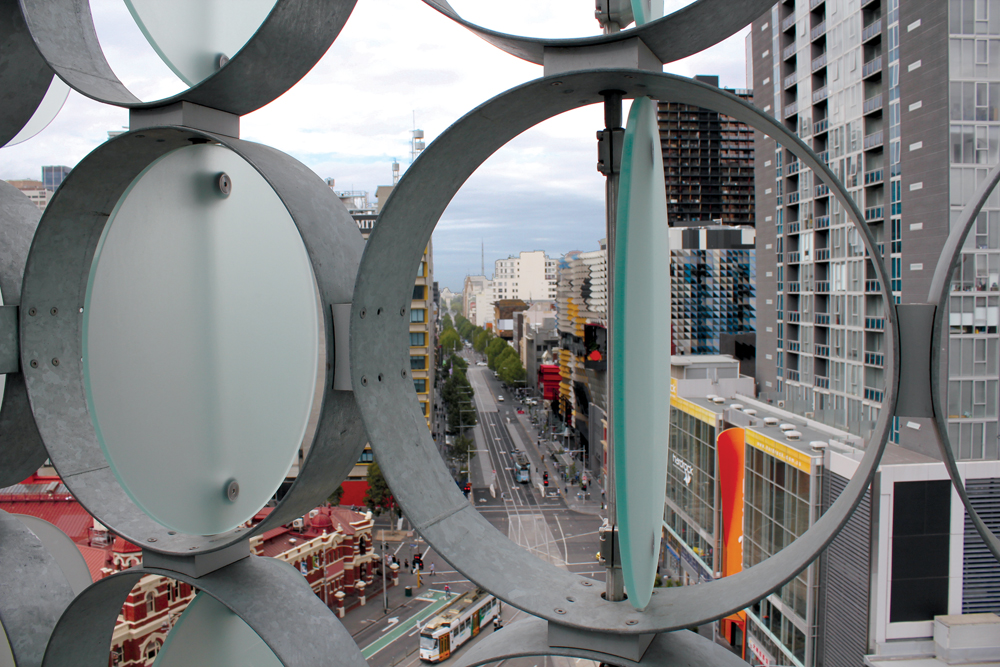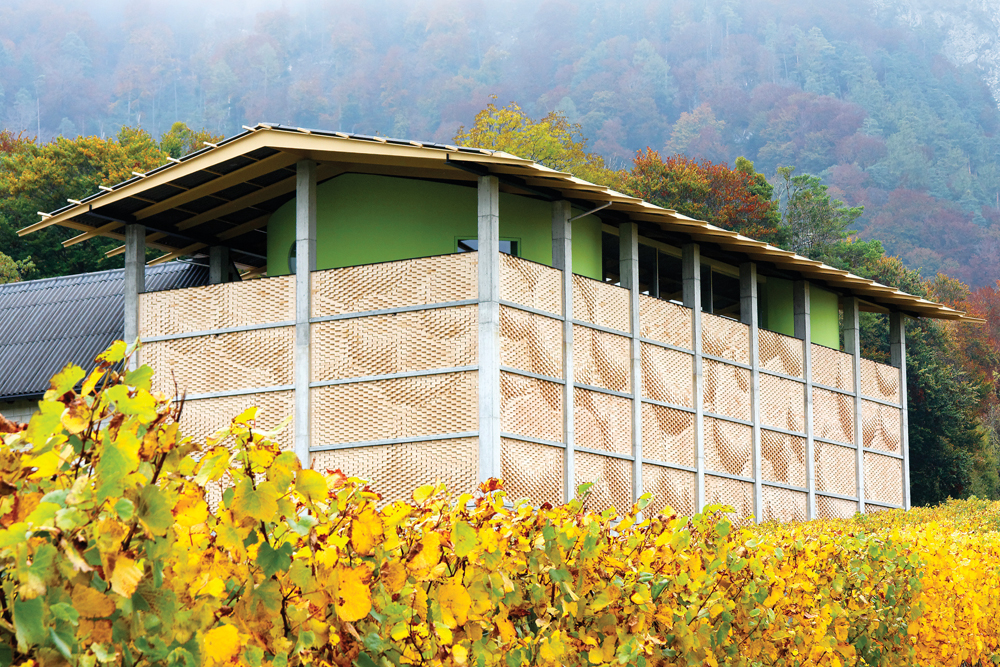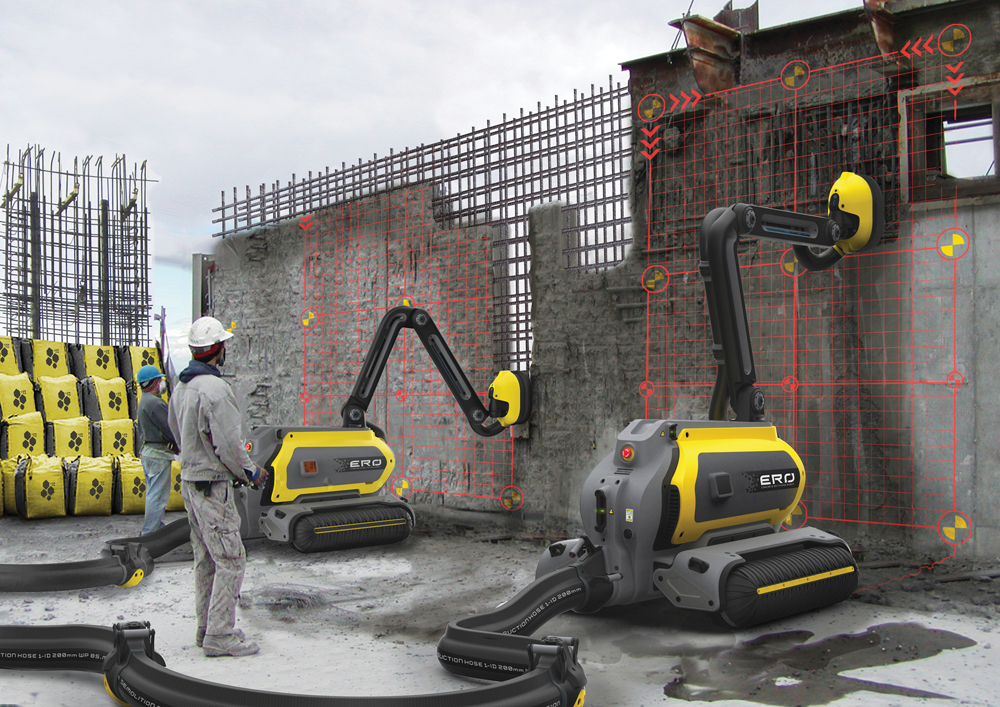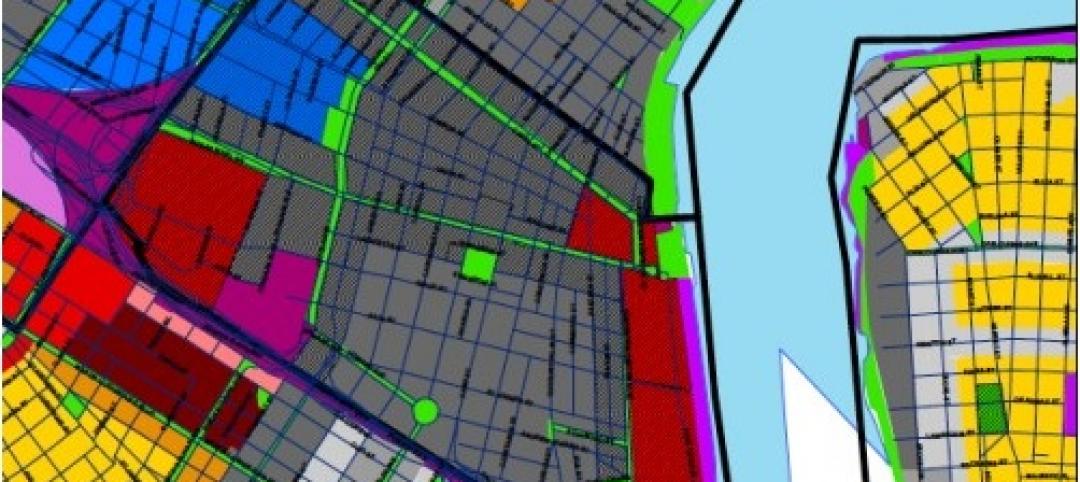This article is part of BD+C's special five-part Technology Report 2014: Top tech tools and trends for AEC professionals.
Someday Building Teams may look back on today’s construction methods and wonder how we ever got along in those dark ages before bricklaying robots and self-assembling buildings. Or maybe that day is today.
A look at construction technologies in development suggests a near-term revolution in how we build and operate our facilities. A few of these seemingly futuristic technologies are already commercially available and in use today, including 3D printing, unmanned drone aircraft, and robotic construction systems.
One of the most successful areas for applying automation and robotics has been at the building envelope. Some forward-thinking building enclosure designs practically work like animal skin, adjusting their shading and vents to changes in ambient humidity, temperature, and light. Biomimicry is a common influence on these active or dynamic façades, which incorporate moving parts, sensors, and actuators, often tied to the central building automation system.
Properly designed, active façades better regulate interior conditions and reduce energy loads for lighting and HVAC. A handful of real-world examples exist, but experts see broader adoption as unlikely, mainly because of high cost and a strictly long-term proposition for ROI.
Façades Get Active
RMIT University’s Design Hub in Melbourne, Australia, designed by Sean Godsell Architects (www.seangodsell.com), combines a double-glazed curtain wall with a second outer skin—both built by contractor Permasteelisa Group (www.permasteelisagroup.com)—comprising thousands of small, disc-shaped solar collectors.
More than half of the discs automatically pivot to face the sun, which optimizes solar collection and provides shading to the interior. The inner skin, meanwhile, mitigates cooling loads by combining air intakes with fine-mist sprinklers that use rooftop-harvested rainwater.
The most notable commercial example of an advanced, automated façade is PNC Tower in Pittsburgh, designed by Gensler (www.gensler.com), slated for completion in 2015. Focused on delivering a “breathable building,” according to the design team, the enclosure features sensor-controlled air gates in the outer skin. Integrated with a solar chimney and heat sink, the gates bring cool air in as warm air is drawn out above. Stakeholders anticipate the gates will be open up to 42% of the time, achieving a 50% reduction in power loads compared to a baseline of ASHRAE 90.1-2007.
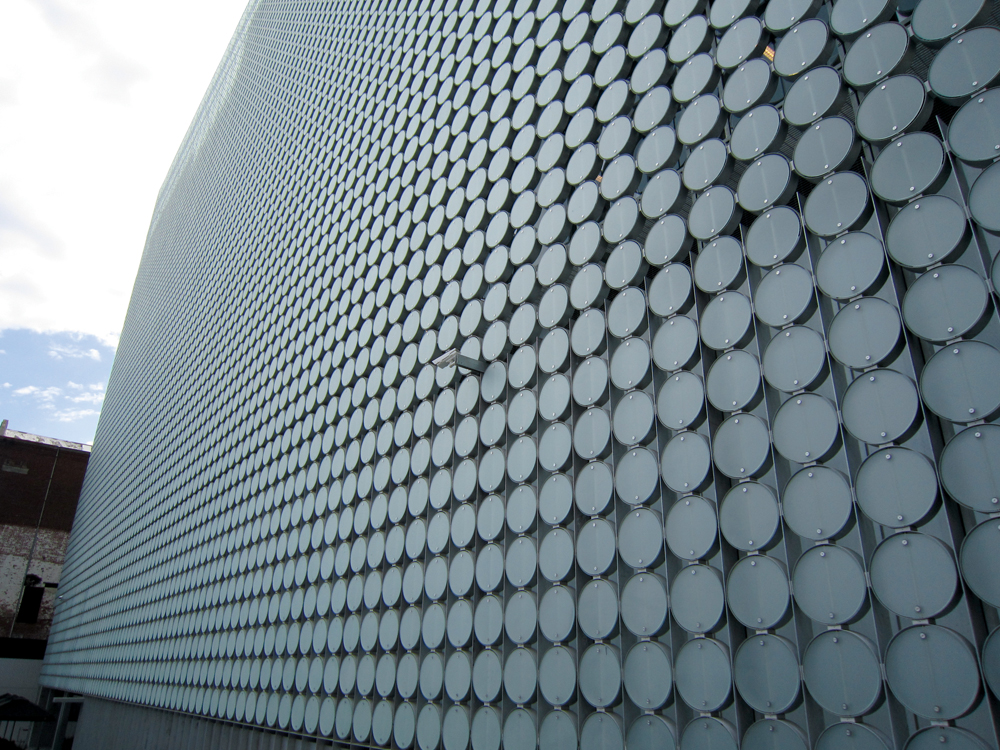
The second, outer skin of RMIT University’s Design Hub in Melbourne, Australia, features thousands of operable PV discs that turn to face the sun, improving solar energy collection and providing a unique shading strategy. Photos: Daniel Walker
Weirdly, biology itself may eventually replace biomimicry. In Hamburg, Germany, the five-story multifamily BIQ House features a “bioreactor” exterior on two of the building’s façades. Developed collaboratively by Arup (www.arup.com), the envelope company Colt Intl. (www.coltinfo.co.uk), and German consultant SSC (www.ssc-hamburg.de), the SolarLeaf façade contains microalgae within its flat glass panels to produce biomass and heat through photosynthesis and collection of solar energy. The microalgae biomass is collected for conversion into biogas—for fuel—and the bioreactor panels even mitigate light transmission, providing a unique shading strategy.
“Using biochemical processes in the façade of a building to create shade and energy might well become a sustainable solution for urban areas,” says Arup architect Jan Wurm.
While many promising active façade concepts have debuted lately—like the twisting, glass-fiber-reinforced plastic fins of South Korea’s Expo Pavilion 2012 and the 60-story Sail Tower in Saudi Arabia, designed by Perkins+Will’s Robert Goodwin (www.perkinswill.com)—all are custom-built or even experimental technologies. The future will really arrive when these systems are easily replicated and readily marketable, say experts.
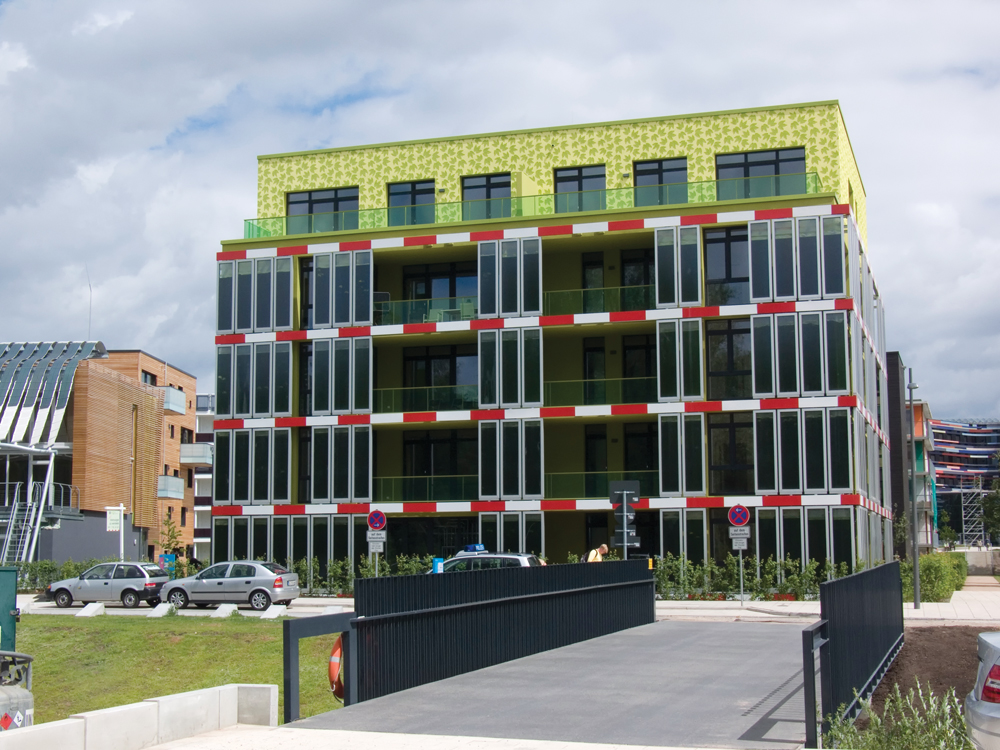
The BIQ House in Hamburg, Germany, affectionately nicknamed “the Clever Treefrog,” utilizes a bioreactor façade design. The glazing panels contain microalgae that react to sunlight, producing biomass. This unusual design combines shading and a unique fuel source for heat for the building.
3D Printing Goes Big
Before that happens, Building Teams might see large-scale 3D printers that are able to print a whole building.
That’s no exaggeration. From an investor’s viewpoint, 3D printing has entered its gold rush phase, according to tech consultant Christopher Winnan, who recently published a book on the subject (3D Printing: The Next Technology Gold Rush – Future Factories and How to Capitalize on Distributed Manufacturing).
The race is on to stake a claim in 3D printing on a massive scale. The industry is a long way off from being able to print an entire structure, yet the notion of creating building components of any shape has the industry buzzing, and busily R&D-ing.
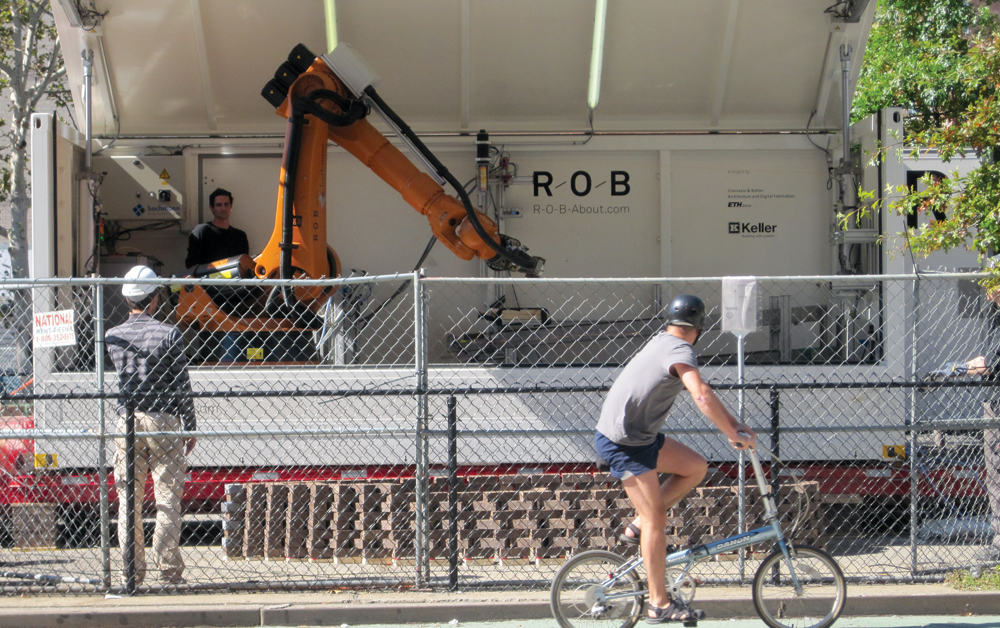
Gramazio & Kohler’s R-O-B mobile fabrication unit was used in New York to create one of the firm’s Structural Oscillations art installations. The project debuted at the 11th Venice Architectural Biennale.
Currently, the world’s largest 3D printer is the CAD-software-controlled D-Shape, developed by Enrico Dini. The printer had been used to create large-scale sculptures, which attracted the attention of Dutch architect Janjaap Ruijssenaars (www.universearchitecture.com). He saw the technology as a way to build his highly conceptual Möbius strip-inspired Landscape House. Dini and Ruijssenaars are currently at work on the looping structure, which will be composed of about 50% 3D-printed parts.
Meanwhile, recent research at the Massachusetts Institute of Technology’s MIT Media Lab has focused on the problem of resolution. Large-scale printing often produces rough, misshapen-looking results. But the components printed at MIT can be sanded down on the exterior to create a finished appearance. For mass and stability, the printed shells are filled with concrete.
London-based Softkill Design (www.softkilldesign.berta.me) tut-tuts these partially printed approaches. Their goal is a single-story structure that will be made of 100% printed components. Their system dispenses lightweight plastic in a web-like configuration that makes it structurally sound. The finished dwelling resembles a spider’s egg sac, but Softkill is particularly proud of the technology’s speed. The firm expects to print all parts of the 26x13-foot house in three weeks, and snap them together in a day.

Gramazio & Kohler employed their R-O-B bricklaying robot to build this service building at the Gantenbein winery in Fläsch, Switzerland. The algorithmic software automatically places the bricks in 3D patterns that increase stability and add artful effects. Photos: Christoph Kadel
The technology is wrestling with trade-offs: print fast and lose resolution; print big and lose speed. The Dutch firm DUS (www.dusarchitects.com) can print an entire room at once—a technique it’s using to build an Amsterdam canal house—but the traditional-looking structure will take three years to finish. Nevertheless, the promise of a future in which Building Teams can single-handedly build any structure they dream up—fast, cheap, and structurally sound—has attracted huge amounts of capital.
In fact, some investors are shooting for the moon—literally. The race is on to make 3D printers for construction sites on the moon. Dini has teamed up with British architect Foster + Partners (www.fosterandpartners.com) on a lunar site for D-Shape, while NASA has revealed a simulation of lunar housing construction using Contour Crafting technology developed at the University of Southern California’s Viterbi School of Engineering. Neither group is very close to selling moon condos, but Contour Crafting is fast: just 20 seconds per square foot of wall.
Building With Drones
Like 3D printing, flying drones make themselves useful in a number of construction tasks, such as pipeline and cell-tower inspection, search and rescue in visually obscured areas such as mines, and even as tools for herding cattle or delivering packages. With the price of the technology dropping fast, AEC firms are putting drones to work with increasing frequency.
A construction site is a natural fit for quick visual inspections by an aerial drone. Add specialized camera technology, such as infrared filters or sensors to detect gas leaks, and the drone becomes invaluable, returning rich, multi-layered data and saving the cost and risk associated with human inspection of hard-to-reach areas.
Some drone types offer surprising accuracy, especially those that utilize multiple propellers for added stability. Building sector stakeholders both small and large have begun to employ quad-copters (QCs) equipped with high-resolution cameras, laser scanning rigs, and gyroscopic stabilization.
Combining these technologies can return micro-metrically accurate data. Purveyors of residential and commercial solar panel arrays, like Toronto’s Kiosk Solar, have used drones to accurately inspect clients’ structures to create proposals for installations. Manufacturer Siemens envisions a future in which QCs fly through existing structures to obtain comprehensive building information for creating 3D digital models. This type of BIM model could assist in determining maintenance needs, and even plan renovations via digital 3D simulation.
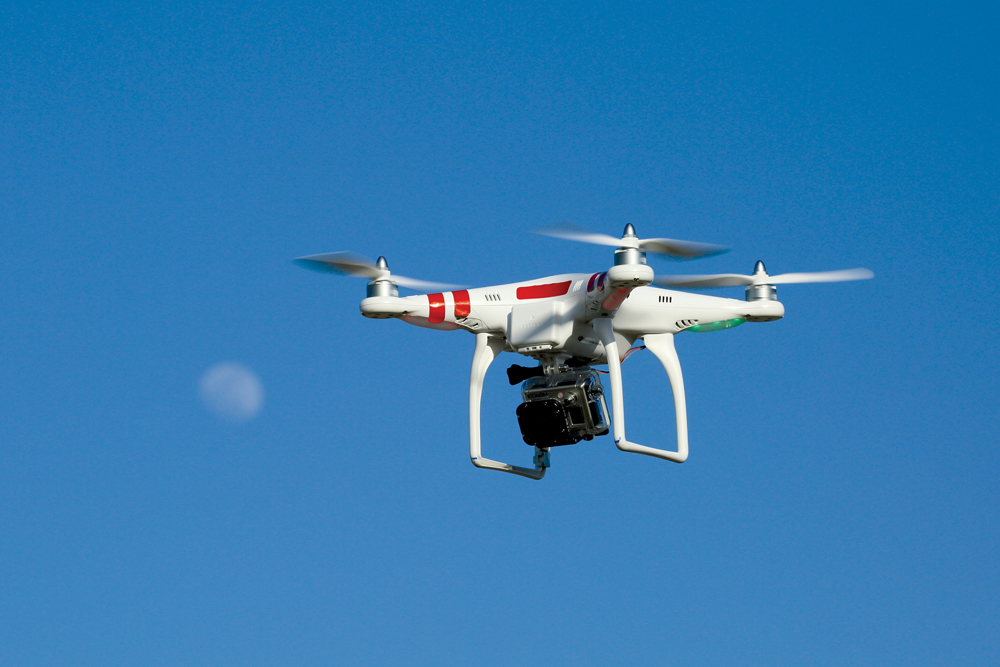
Flying drones with multiple propellers, like the quadcopter shown here, offer stability that greatly increases their usefulness in tasks like obtaining measurements and laser scanning. This is especially true for those with gyroscopic stabilization.
What industry futurists really want to know is, can drones be put to work actually building? That day may come sooner than many realize.
The Swiss firm Gramazio & Kohler (www.gramaziokohler.com) recently collaborated on Flight Assembled Architecture, a large-scale art installation at the FRAC Centre in Orléans, France, in which a team of as many as 50 flying robots built a structurally stable, six-foot tower out of 1,500 Styrofoam blocks.
Multiple motion-capture sensors detected the drones at a speed of 370 feet per second, feeding the information into a fleet management program. The impressive thing about this installation is not the finished tower itself but rather the programming. The algorithms determine how to dispatch the drones efficiently, avoiding collisions and opting for best-case paths to fast payload pickup and release.
Could this process be scaled up? Could drones be designed to, for example, carry bricks and dispense mortar to automate masonry construction? If that seems far-fetched, consider Gramazio & Kohler’s down-to-earth model for robotic construction. The firm helped create R-O-B Technologies (www.rob-technologies.com), which developed a mobile fabrication unit that fits in a modified freight container and can perform several construction tasks.
The enormous robotic arm employs algorithms to perform autonomously, and is particularly adept at bricklaying. R-O-B’s robots built the Structural Oscillations art installations in Venice and New York, as well as a real-world application: the non-standardized brick façade of a service building in Fläsch, Switzerland, for the Gantenbein Winery.
R-O-B’s algorithmic software creates dynamic 3D walls and forms. The undulations increase stability and provide visual interest. For example, the winery building’s walls, viewed from a distance, look like a dimensional depiction of a bunch of grapes.
All of this is a long way from widespread market availability, but some see robotic masonry as inevitable. In the U.S., Construction Robotics (www.construction-robotics.com) has been wading through a years-long R&D process and soon could see its Semi-Automated Masonry system become commercially viable.
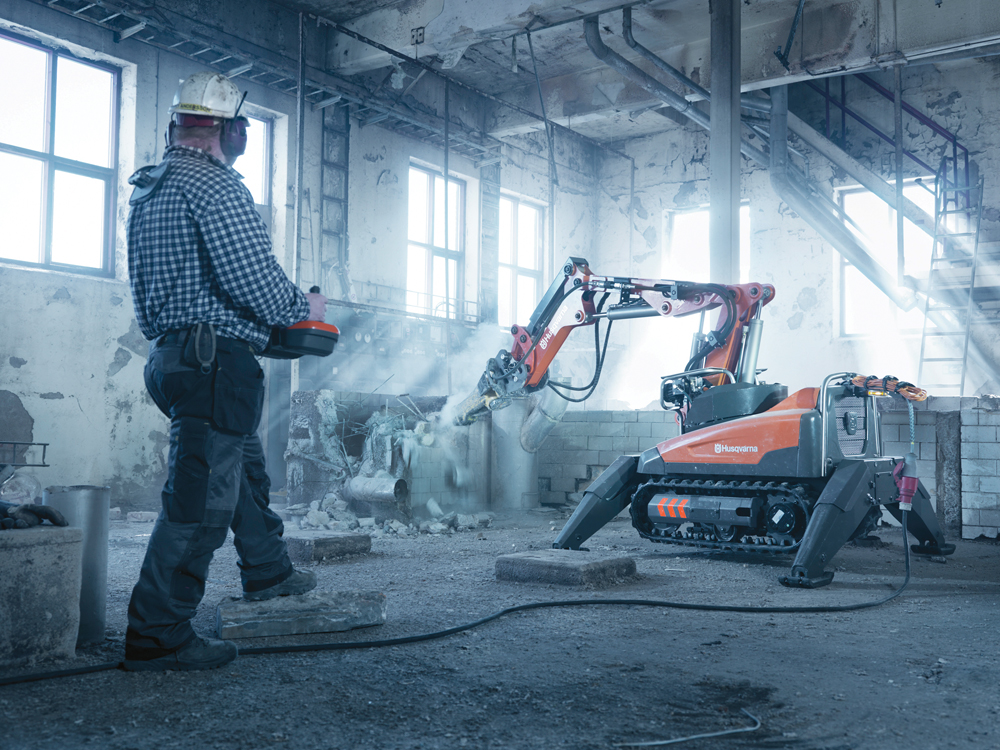
TOP IMAGE: ERO, a demolition robot on caterpillar-style treads, uses water jets to “erase” concrete into aggregate and leave behind pristine, recyclable rebar. Developed in Sweden, the robots can be algorithmically automated to work in teams to quickly take down concrete structures.
BOTTOM IMAGE: Husqvarna’s DXR140 demolition robot in action. The robot shown here is controlled by remote human operation, though other models may be fully automated.
For those who absolutely can’t wait to get robots involved in their projects, consider demolition. Manufacturers Brokk (www.brokk.com/us) and Husqvarna (www.husqvarna.com) produce commercially available robots that cut, crush, drill, and otherwise make quick work of turning structures into rubble. Most models are remote controlled, but autonomy is on the horizon.
Sweden’s Omer Haciomeroglu has developed ERO (www.omerh.com), a deconstruction robot on caterpillar-style treads that “erases” concrete from reinforced walls while leaving the rebar clean and ready for reuse or scrap. The robot removes the concrete using powerful water jets, recycling the water and separating the concrete into aggregate. Sophisticated software could someday send a fleet of EROs to scan, plan, and sustainably erase a building without significant human intervention.
Even More Future Tech
Some future technologies are aimed at related fields like civil engineering, such as satellite control of major construction equipment using GPS and the Global Navigation Satellite System (GNSS). Others fall into IT categories, such as Big Data and predictive analytics modeling, which architecture and planning firms will begin to employ before deciding, for example, which projects to take on and which to avoid.
At times, it may seem hard to distinguish between the fanciful and the potentially fruitful. For instance, there are those who quite seriously discuss a future of 4D printing, which involves printing a small item that grows much larger after adding water. This notion, previously seen only in Bugs-Bunny-on-Mars-type cartoons, is considered by some to be a realistic component of future construction.
Self-assembling blocks seem equally unlikely, and yet MIT research into the idea has produced M Blocks, a system of discrete cubes with no external moving parts that can assemble, then break apart and reassemble in a new shape. Microchips and wireless signals control the internal moving parts, and magnets snap the pieces together firmly.
The technology does not seem useful now, but it represents a precursor to a fundamental shift in the way buildings are designed, constructed, and operated. Imagine a future in which an owner can make architectural changes to a structure, on a whim.
Unlikely? Perhaps. But we are surrounded on all sides by the previously unlikely.
Related Stories
| May 18, 2011
One of Delaware’s largest high schools seeks LEED for Schools designation
The $82 million, 280,000-sf Dover (Del.) High School will have capacity for 1,800 students and feature a 900-seat theater, a 2,500-seat gymnasium, and a 5,000-seat football stadium.
| May 18, 2011
Carnegie Hall vaults into the 21st century with a $200 million renovation
Historic Carnegie Hall in New York City is in the midst of a major $200 million renovation that will bring the building up to contemporary standards, increase educational and backstage space, and target LEED Silver.
| May 17, 2011
Redesigning, redefining the grocery shopping experience
The traditional 40,000- to 60,000-sf grocery store is disappearing and much of the change is happening in the city. Urban infill sites and mixed-use projects offer grocers a rare opportunity to repackage themselves into smaller, more efficient, and more convenient retail outlets. And the AEC community will have a hand in developing how these facilities will look and operate.
| May 17, 2011
Architecture billings index fell in April, hurt by tight financing for projects
The architecture billings index, a leading indicator of U.S. construction activity, fell in April, hurt by tight financing for projects. The architecture billings index fell 2.9 points last month to 47.6, a level that indicates declining demand for architecture services, according to the American Institute of Architects.
| May 17, 2011
Sustainability tops the syllabus at net-zero energy school in Texas
Texas-based firm Corgan designed the 152,200-sf Lady Bird Johnson Middle School in Irving, Texas, with the goal of creating the largest net-zero educational facility in the nation, and the first in the state. The facility is expected to use 50% less energy than a standard school.
| May 17, 2011
Gilbane partners with Steel Orca on ultra-green data center
Gilbane, along with Crabtree, Rohrbaugh & Associates, has been selected to partner with Steel Orca to design and build a 300,000-sf data center in Bucks County, Pa., that will be powered entirely through renewable energy sources--gas, solar, fuel cells, wind and geo-thermal. Completion is scheduled for 2013.
| May 17, 2011
Should Washington, D.C., allow taller buildings?
Suggestions are being made that Washington revise its restrictions on building heights. Architect Roger Lewis, who raised the topic in the Washington Post a few weeks ago, argues for a modest relaxation of the height limits, and thinks that concerns about ruining the city’s aesthetics are unfounded.
| May 17, 2011
The New Orleans master plan
At an afternoon panel during last week's AIA National Conference in New Orleans, Goody Clancy Principal David Dixon and Manning Principal W. Raymond Manning shared their experiences creating the New Orleans Master Plan, a document that sets a new course for the city, from land use and transportation planning to environmental protection.
| May 17, 2011
Do these buildings look like buffalo to you?
It’s hard to contemplate winter now that we’re mid-spring, but when the seasons change, ice skaters in Winnipeg will be able to keep warm in plywood shelters designed by Patkau Architects. The designers created temporary shelters inspired by animal behavior—specifically, buffalo bracing against the wind. Check them out.



